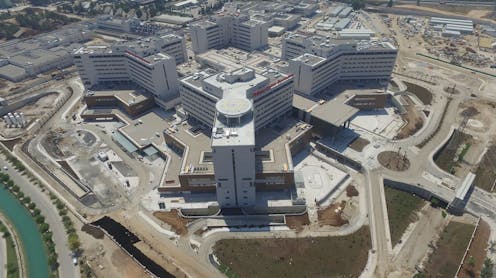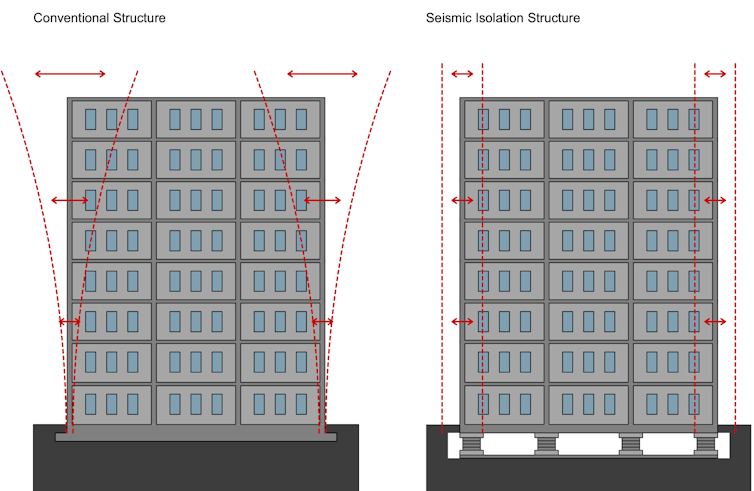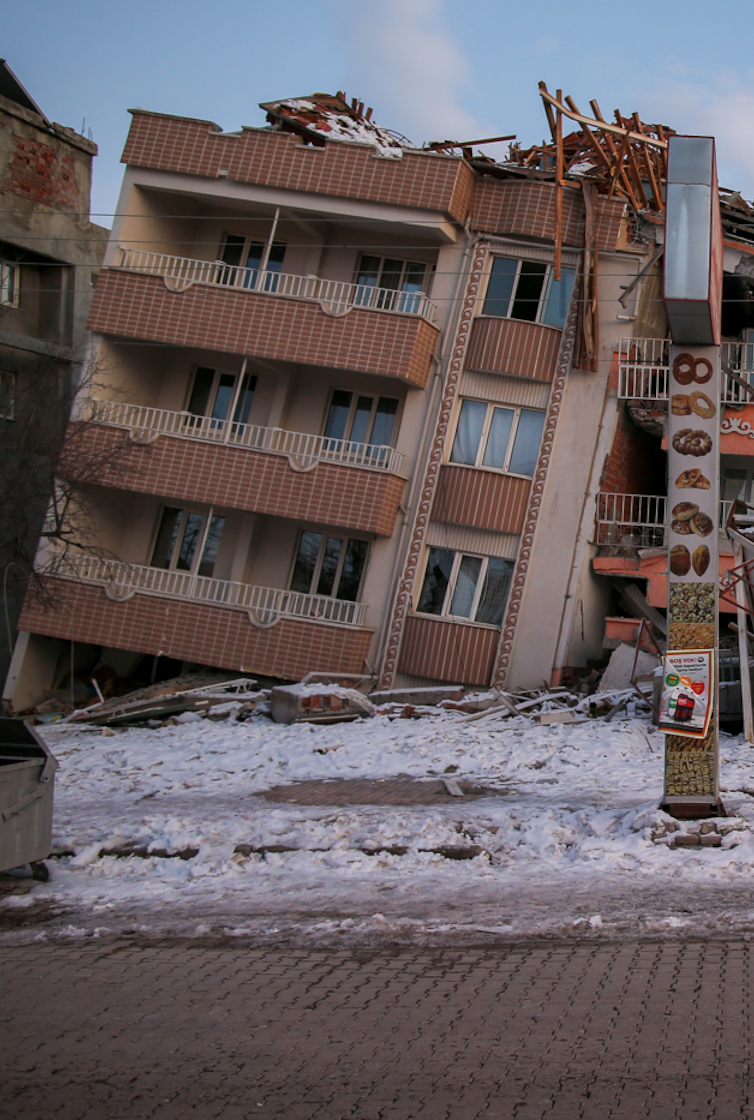
The Feb. 6, 2023, earthquakes in Turkey and Syria damaged over 100,000 buildings, caused more than 10,000 collapses and killed more than 50,000 people. These earthquakes also put to the test advanced building technologies that can minimize damage and keep buildings functioning after a quake.
Several hospitals built with one such technology – called a seismic isolation system – survived the earthquakes with almost no harm, according to local news reports, even while surrounding buildings sustained heavy damage.
Adana City Hospital was built to record both ground shaking and the building’s response. Thanks to its seismic isolation system, the building saw a 75% reduction in shaking, according to the company that designed the isolation system, compared with neighboring structures. This system allowed the building to stay up and running after the earthquake.
Engineers aren’t surprised that the hospitals with seismic isolation systems survived with minimal damage, but through my work as a civil engineer, I’ve been hearing people in Turkey and abroad ask why more buildings don’t use these smarter engineering technologies.
A year after the 1999 İzmit earthquake in Turkey killed over 17,000 people, I moved to Istanbul for a bachelor’s in civil engineering. I moved to the U.S. for my graduate studies in 2005, and since then, I have been working on advanced technologies and materials that can ensure rapid recovery and reoccupation of buildings after a strong earthquake.
Although we’ve seen the effectiveness of seismic protection technologies during past major earthquakes, these technologies have been installed in only a tiny fraction of the places where they could potentially be useful.
Earthquake-resilient building technology
Engineers can control how structures respond to earthquakes in several ways.
Traditional approaches rely on having certain components of the building, like columns or beams, absorb the earthquake’s energy. However, this method can lead to damage accumulating in these structural features that may render the building uninhabitable.
Earthquake-resilient systems such as seismic isolation devices and seismic dampers minimize the seismic energy that goes into these columns or beams by either absorbing it or diverting it. As a result, the building experiences less motion and damage and is more likely to remain functional after an earthquake.
Seismic isolation systems prevent seismic energy from entering buildings in the first place by using devices made from rubber or steel plates coated with a friction-generating material that slide over one another to minimize an earthquake’s impact. These isolation devices are installed between the building’s foundation and the building itself. Alternatively, seismic dampers, installed in each story of a building, absorb earthquake energy the way shock absorbers work in a car and convert it into heat energy to minimize damage.

Both seismic isolation systems and seismic dampers can help a building achieve “functional recovery” – a performance objective whereby buildings are constructed to prevent damage and enable reoccupancy. Designing such buildings will not only save people and buildings but also keep the earthquakes from collapsing communities and economies.
While functional recovery is an emerging idea for building earthquake-resilient structures, global modern building codes stipulate that, at a minimum, structures must have measures in place to keep the building from collapsing – called the life safety objective. Buildings following a life safety objective are engineered to sustain damage in a controlled way, to keep the building standing and protect those inside.
While these buildings likely won’t collapse, they may not be safe to use after a quake. While this is not the same as functional recovery, if more buildings had been built to a life safety threshold in Turkey and Syria, thousands of lives could have been saved.
The case in Turkey
Much of the damage in Turkey occurred in nonductile concrete buildings constructed under a pre-1998 Turkish building code. Ductile concrete building elements, required by newer building codes, are more flexible, thanks to steel reinforcing bars at critical locations. They can accommodate the building motions induced by earthquakes. The older nonductile buildings also tended to have poorly arranged steel reinforcements, leaving them vulnerable to the sudden collapse of building columns.
Similarly, many so-called soft-story buildings were damaged during these earthquakes. A soft story is a level that is significantly more vulnerable to lateral earthquake forces than the other stories in a multistory building. The first floor of these buildings – commonly used for commercial purposes like retail, garage or office space – tend to have more open areas and fewer structural components, like beams and columns, making them vulnerable to collapse.

These types of buildings are found all over the world, including in highly populated, seismically at-risk areas like Istanbul, San Francisco, Los Angeles and Vancouver — all located near active fault lines.
Buildings designed under old codes can be strengthened to meet a life safety performance threshold. However, these upgrades can cost lots of money, and enforcing these upgrades, especially for private buildings, requires well-planned policies.
Learning lessons
While buildings designed for a life safety objective can protect thousands of lives, the February 2011 Christchurch earthquake in New Zealand revealed the limitations of modern seismic codes centered solely on this design goal. The damage to buildings designed under a life safety goal was so extensive that thousands had to be demolished after the quake.
It was this earthquake that led engineers to focus on “functional recovery” and to implement seismic protective technologies more widely. The additional cost of such seismic protection technologies is typically less than 5% of the initial construction costs and pales in comparison to the cost of the social and economic disruptions caused by a major earthquake. In addition, securing lower insurance premiums may recoup most of these initial costs.
Total economic losses after the Christchurch earthquake was estimated at US$32 billion, not accounting for inflation, of which $24 billion was construction costs. The cost of the recent earthquakes in Turkey is estimated to be more than $84 billion and still counting.
The earthquakes in Turkey have shown that seismic protection technologies work. To avoid high economic and social consequences, local authorities can update the provisions and codes for designing new buildings to enable post-earthquake reoccupancy and functional recovery. Additionally, policies, financial incentives and tax benefits that promote enhanced building design could improve seismic safety on a larger scale.
Osman Ozbulut receives funding from NSF.
This article was originally published on The Conversation. Read the original article.







